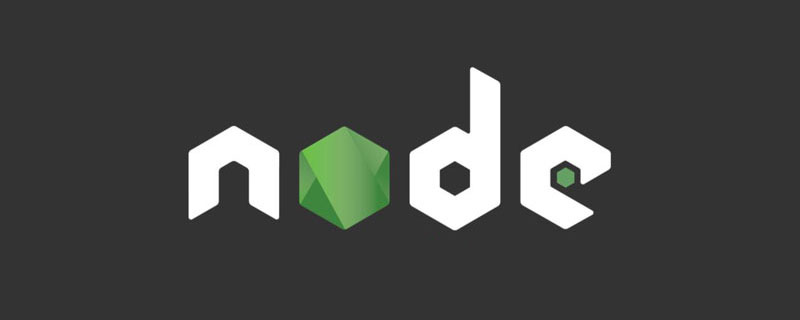NodeJS를 사용하여 HTTP 서버를 만드는 방법은 무엇입니까? 다음 글에서는 Node를 사용하여 간단한 HTTP 서버를 만드는 방법을 소개하겠습니다. 도움이 되길 바랍니다.

1. Node.js를 사용하여 JavaScript 스크립트를 직접 실행
node.jsnode.js基于Chrome的v8引擎运行js代码,因此我们可以摆脱浏览器环境,直接在控制台中运行js代码,比如下面这个hello world代码
console.log('hello world');
控制台中直接使用node即可运行

2. 创建一个简单的HTTP服务器
node.js的内置模块http提供了基本的http服务的能力,基于CommonJS规范,我们可以使用require导入http模块进行使用http模块中有一个createServer函数能够让我们创建一个httpChromev8 엔진 기반 /code> js 코드를 실행하면 브라우저 환경을 제거하고 다음 hello world와 같이 콘솔에서 직접 js 코드를 실행할 수 있습니다. code> code request和response
-
request包括所有客户端请求的信息,比如url、请求头header、请求方式和请求体等 -
response主要用于返回信息给客户端,封装了一些操作响应体相关的操作,比如response.writeHead方法就可以让我们自定义返回体的头部信息和状态码
当我们将响应体处理好了之后,调用response.end()
const { createServer } = require('http');
const HOST = 'localhost';
const PORT = '8080';
const server = createServer((req, resp) => {
// the first param is status code it returns
// and the second param is response header info
resp.writeHead(200, { 'Content-Type': 'text/plain' });
console.log('server is working...');
// call end method to tell server that the request has been fulfilled
resp.end('hello nodejs http server');
});
server.listen(PORT, HOST, (error) => {
if (error) {
console.log('Something wrong: ', error);
return;
}
console.log(`server is listening on http://${HOST}:${PORT} ...`);
});
createServer函数只是帮我们创建了一个Server对象,并没有让其开启监听,我们还需要调用server对象的listen方法才可以进行监听,真正作为一个服务器开始运行-
listen方法的第一个参数是监听的端口号,第二个参数则是绑定的主机ip,第三个参数是一个回调函数,会被http模块异步调用,当遇到错误的时候,就能够在这个回调函数的第一个参数中获取到抛出的异常 ,我们可以选择对异常进行处理,让我们的服务器更加健壮
下面是使用http模块创建一个简单服务器的例子
npm i -g nodemon
可以直接尝试用node运行它,创造一个属于你的服务器!服务器运行后,浏览器访问http://localhost:8080即可访问到这个服务器

也可以使用nodemon运行它,这样当我们的代码发生变化的时候就不需要手动终止程序再重新运行了
nodemon http-server.js
建议全局安装它,这样就可以直接使用,不需要通过npx nodemon 콘솔에서 직접 node를 사용하여 실행node命令改成nodemon命令即可
{ "compilerOptions": {
"checkJs": true
},
"exclude": ["node_modules", "**/node_modules/*"]
}

3. 加上类型提示
前面我们在使用createServer以及resp对象的时候,看不到任何的语法提示,必须随时跟着nodets的.d.ts文件帮助我们提供语法提示功能,注意,我们不是使用ts进行开发,只是使用它的语法提示功能而已
- 初始化项目 --
npm init -y - 安装
@types/node--pnpm i @types/node -D - 在项目目录下创建
jsconfig.json文件,将node_modules排除在外,没必要对其进行检查
const { createServer } = require("http");
const HOST = "localhost";
const PORT = 8080;
const server = createServer((req, resp) => {
resp.writeHead(200, { "Content-Type": "text/plain" });
console.log("server is working...");
// write some lorem sentences
resp.write("Lorem ipsum dolor sit amet consectetur adipisicing elit.\n");
resp.write("Omnis eligendi aperiam delectus?\n");
resp.write("Aut, quam quo!\n");
resp.end();
});
server.listen(PORT, HOST, (error) => {
if (error) {
console.log("Something wrong: ", error);
return;
}
console.log(`server is listening on http://${HOST}:${PORT} ...`);
});
不知道你是否有发现上面的代码其实是有一处错误的呢?checkJs
 2. 간단한 HTTP 서버 만들기
2. 간단한 HTTP 서버 만들기
listennode.js 내장- http 모듈에서는 기본 http 서비스 기능을 제공합니다. CommonJS 사양을 기반으로 require를 사용하여 가져올 수 있습니다. http 모듈 http 모듈에는 http 서버를 생성할 수 있는 createServer 함수가 있습니다.
콜백 함수를 매개변수로 받습니다. 이 콜백 함수는 요청 및 응답
-
요청이라는 두 개의 매개변수를 받습니다.url, 요청 헤더header, 요청 방법 및 요청 본문 등 클라이언트가 요청한 정보 -
응답주로 클라이언트에 정보를 반환하고 응답 본문과 관련된 일부 작업을 캡슐화하는 데 사용됩니다. 예를 들어response.writeHead메서드를 사용하면 반환 본문의 헤더 정보와 상태 코드를 사용자 정의할 수 있습니다. 🎜응답 본문을 처리한 후 - 메서드의 첫 번째 매개변수는 수신 포트 번호이고 두 번째 매개변수는 바인딩된 호스트
ip입니다. 세 개의 매개변수는http모듈에 의해 비동기적으로 호출되는 콜백 함수입니다. 오류가 발생하면 이 콜백 함수의 첫 번째 매개변수에서 예외를 처리하도록 선택할 수 있습니다. 서버를 더욱 강력하게 만들기 위한 예외
response.end() 메서드를 호출하여 클라이언트에 응답 본문을 보냅니다.
createServer 함수를 사용하면 Server 개체가 생성되지만 모니터링할 수는 없습니다. 또한 server의 🎜 메서드를 호출해야 합니다. code> 객체를 모니터링하고 실제로 서버로 실행할 수 있습니다🎜http 모듈을 사용하여 간단한 서버를 만드는 예입니다🎜const { createServer } = require("http");
const fs = require("fs");
const HOST = "localhost";
const PORT = 8080;const server = createServer((req, resp) => {
// change the MIME type from text/plain to text/html
resp.writeHead(200, { "Content-Type": "text/html" });
// read the html file content
fs.readFile("index.html", (err, data) => {
if (err) {
console.error(
"an error occurred while reading the html file content: ",
err
); throw err;
}
console.log("operation success!");
resp.write(data);
resp.end();
});
});
server.listen(PORT, HOST, (error) => {
if (error) {
console.log("Something wrong: ", error);
return;
}
console.log(`server is listening on http://${HOST}:${PORT} ...`);
});🎜node를 직접 사용해 볼 수 있습니다 실행하고 나만의 서버를 만들어보세요! 서버가 실행된 후 브라우저는 http://localhost:8080🎜이 서버에 액세스할 수 있습니다🎜🎜 🎜🎜
🎜🎜nodemon을 사용하여 실행할 수도 있습니다. 변경사항 그러면 프로그램을 수동으로 종료하고 다시 실행할 필요가 없습니다🎜const { createServer } = require("http");
const HOST = "localhost";
const PORT = 8080;
const server = createServer((req, resp) => {
// change the MIME type to application/json
resp.writeHead(200, { "Content-Type": "application/json" });
// create a json data by using an object
const jsonDataObj = {
code: 0,
message: "success",
data: {
name: "plasticine",
age: 20,
hobby: "coding",
},
};
resp.write(JSON.stringify(jsonDataObj));
resp.end();
});
server.listen(PORT, HOST, (error) => {
if (error) {
console.log("Something wrong: ", error);
return;
}
console.log(`server is listening on http://${HOST}:${PORT} ...`);
});🎜npx nodemon을 사용하지 않고 바로 사용할 수 있도록 전역으로 설치하는 것을 권장합니다.
사용하기도 매우 간단합니다. node 명령을 nodemon 명령🎜pnpm i pdfkit🎜
 🎜
🎜🎜🎜3. 유형 힌트 추가🎜🎜🎜
를 사용하고 있었습니다. 이전에Server 및 resp 객체를 생성할 때 구문 프롬프트를 볼 수 없습니다. 사용하는 동안 언제든지 node의 공식 문서를 따라야 합니다. 조금 불편합니다.
하지만 문제가 되지 않습니다. ts의 .d.ts 파일을 사용하여 구문 프롬프트를 제공할 수 있습니다. ts를 개발용으로 사용하세요.🎜<ol>
<li>프로젝트 초기화-- <code>npm init -y
@types/node 설치 - - pnpm i @types/node -D
jsconfig.json 파일을 생성하고 를 제외합니다. node_modules 외부에서는 확인할 필요가 없습니다/**
* @description 创建 pdf 文件
*/const createPdf = () => {
return new Promise((resolve, reject) => {
if (!fs.existsSync("example.pdf")) {
// create a PDFDocument object
const doc = new PDFDocument();
// create write stream by piping the pdf content.
doc.pipe(fs.createWriteStream("example.pdf"));
// add some contents to pdf document
doc.fontSize(16).text("Hello PDF", 100, 100);
// complete the operation of generating PDF file.
doc.end();
}
resolve("success");
});
};🎜위 코드에 실제로 오류가 있다는 것을 발견하셨는지 궁금합니다. checkJs는 유형 오류를 확인하는 데 도움이 됩니다. 필요에 따라 활성화 여부를 선택할 수 있습니다.
보시다시피 체크를 켜면 바로 매개변수 유형 불일치 문제가 발생합니다🎜🎜🎜🎜🎜이때 🎜 메소드 위에 마우스를 올리면 해당 메소드의 서명을 볼 수 있습니다🎜
可以看到,原来port参数需要是number类型,但是我们定义的时候是string类型,所以没匹配上,将其修改为number的8080即可
而且可以直接查看到相关api的文档,不需要打开node官方的文档找半天去查看了
4. 返回多个字符串的响应体
前面我们的简单http server中只返回了一句话,那么是否能够返回多句话呢?
这就要用到resp对象的write方法了,end只能够返回一次内容,而是用write方法,我们可以多次写入内容到响应体中,最后只用调用一次end,并且不传递任何参数,只让他完成发送响应体的功能
const { createServer } = require("http");
const HOST = "localhost";
const PORT = 8080;
const server = createServer((req, resp) => {
resp.writeHead(200, { "Content-Type": "text/plain" });
console.log("server is working...");
// write some lorem sentences
resp.write("Lorem ipsum dolor sit amet consectetur adipisicing elit.\n");
resp.write("Omnis eligendi aperiam delectus?\n");
resp.write("Aut, quam quo!\n");
resp.end();
});
server.listen(PORT, HOST, (error) => {
if (error) {
console.log("Something wrong: ", error);
return;
}
console.log(`server is listening on http://${HOST}:${PORT} ...`);
});
这次我们写入了三句话,现在的效果就变成这样啦

5. 返回html
我们不仅可以返回字符串给浏览器,还可以直接读取html文件的内容并将其作为结果返回给浏览器
这就需要用到另一个Node.js的内置模块 -- fs,该模块提供了文件操作的功能
使用fs.readFile可以异步进行读取文件的操作,但是它不会返回promise对象,因此我们需要传入回调去处理读取到文件后的操作
还可以使用fs.readFileSync进行同步阻塞读取文件,这里我们选择异步读取
const { createServer } = require("http");
const fs = require("fs");
const HOST = "localhost";
const PORT = 8080;const server = createServer((req, resp) => {
// change the MIME type from text/plain to text/html
resp.writeHead(200, { "Content-Type": "text/html" });
// read the html file content
fs.readFile("index.html", (err, data) => {
if (err) {
console.error(
"an error occurred while reading the html file content: ",
err
); throw err;
}
console.log("operation success!");
resp.write(data);
resp.end();
});
});
server.listen(PORT, HOST, (error) => {
if (error) {
console.log("Something wrong: ", error);
return;
}
console.log(`server is listening on http://${HOST}:${PORT} ...`);
});
现在的结果就像下面这样:

成功将html返回注意:这里需要将响应头的**Content-Type**改为**text/html**,告知浏览器我们返回的是**html**文件的内容,如果仍然以**text/plain**返回的话,浏览器不会对返回的内容进行解析,即便它是符合**html**语法的也不会解析,就像下面这样:
6. 返回JSON
当我们需要编写一个后端服务器,只负责返回接口数据的时候,就需要返回json格式的内容了,相信聪明的你也知道该怎么处理了:
- 将
MIME类型设置为application/json -
resp.write的时候传入的是json字符串,可以使用JSON.stringify处理对象后返回
const { createServer } = require("http");
const HOST = "localhost";
const PORT = 8080;
const server = createServer((req, resp) => {
// change the MIME type to application/json
resp.writeHead(200, { "Content-Type": "application/json" });
// create a json data by using an object
const jsonDataObj = {
code: 0,
message: "success",
data: {
name: "plasticine",
age: 20,
hobby: "coding",
},
};
resp.write(JSON.stringify(jsonDataObj));
resp.end();
});
server.listen(PORT, HOST, (error) => {
if (error) {
console.log("Something wrong: ", error);
return;
}
console.log(`server is listening on http://${HOST}:${PORT} ...`);
});
结果如下:
7. 返回pdf文件
和之前返回html文件的思路类似,都是一个设置响应头MIME类型,读取文件,返回文件内容的过程
但是这次我们搞点不一样的
我们的思路是在服务器运行的时候生成一个pdf文件,并将它返回
还需要将MIME的类型改为application/pdf生成pdf文件需要用到一个库 -- pdfkit
pnpm i pdfkit
首先我们编写一个创建pdf文件的函数,因为创建pdf文件还需要进行一些写入操作,不确定什么时候会完成,但是我们的请求必须等到pdf文件创建完成后才能得到响应
所以我们需要将它变成异步进行的,返回一个promise
/**
* @description 创建 pdf 文件
*/const createPdf = () => {
return new Promise((resolve, reject) => {
if (!fs.existsSync("example.pdf")) {
// create a PDFDocument object
const doc = new PDFDocument();
// create write stream by piping the pdf content.
doc.pipe(fs.createWriteStream("example.pdf"));
// add some contents to pdf document
doc.fontSize(16).text("Hello PDF", 100, 100);
// complete the operation of generating PDF file.
doc.end();
}
resolve("success");
});
};
这里使用到了管道操作,将PDFDocument对象的内容通过管道传到新创建的写入流中,当完成操作后我们就通过resovle告知外界已经创建好pdf文件了
然后在服务端代码中调用
const server = createServer(async (req, resp) => {
// change the MIME type to application/pdf
resp.writeHead(200, { "Content-Type": "application/pdf" });
// create pdf file
await createPdf();
// read created pdf file
fs.readFile("example.pdf", (err, data) => {
if (err) {
console.error(
"an error occurred while reading the pdf file content: ",
err
);
throw err;
}
console.log("operation success!");
resp.end(data);
});
});
server.listen(PORT, HOST, (error) => {
if (error) {
console.log("Something wrong: ", error);
return;
}
console.log(`server is listening on http://${HOST}:${PORT} ...`);
});
现在浏览器就可以读取到创建的pdf文件了
8. 返回音频文件
思路依然是一样的,读取一个音频文件,然后通过管道将它送到resp对象中再返回即可
const { createServer } = require("http");
const { stat, createReadStream } = require("fs");
const HOST = "localhost";
const PORT = 8080;
const server = createServer((req, resp) => {
// change the MIME type to audio/mpe
resp.writeHead(200, { "Content-Type": "audio/mp3" });
const mp3FileName = "audio.mp3";
stat(mp3FileName, (err, stats) => {
if (stats.isFile()) {
const rs = createReadStream(mp3FileName);
// pipe the read stream to resp
rs.pipe(resp);
} else {
resp.end("mp3 file not exists");
}
});
});
server.listen(PORT, HOST, (error) => {
if (error) {
console.log("Something wrong: ", error);
return;
}
console.log(`server is listening on http://${HOST}:${PORT} ...`);
});
效果如下
打开后就是一个播放音频的界面,这是chrome提供的对音频文件的展示,并且打开控制台会发现有返回音频文件
注意:将音频文件流通过管道传到**resp**后,不需要调用**resp.end()**方法,因为这会关闭整个响应,导致音频文件无法获取
9. 返回视频文件
视频文件和音频文件的处理是一样的,只是MIME的类型要改成video/mp4,其他都一样
const { createServer } = require("http");
const { stat, createReadStream } = require("fs");
const HOST = "localhost";
const PORT = 8080;
const server = createServer((req, resp) => {
// change the MIME type to audio/mpe
resp.writeHead(200, { "Content-Type": "audio/mp4" });
const mp4FileName = "video.mp4";
stat(mp4FileName, (err, stats) => {
if (stats.isFile()) {
const rs = createReadStream(mp4FileName);
// pipe the read stream to resp
rs.pipe(resp);
} else {
resp.end("mp4 file not exists");
}
});
});
server.listen(PORT, HOST, (error) => {
if (error) {
console.log("Something wrong: ", error);
return;
}
console.log(`server is listening on http://${HOST}:${PORT} ...`);
});
总结
我们学会了:
- 如何使用
Node创建一个http服务器 - 给
js加上类型提示 - 如何返回字符串响应体
- 如何返回
html - 如何返回
JSON - 如何生成并返回
pdf文件 - 如何返回音频文件
- 如何返回视频文件
虽然内容简单,但还是希望你能跟着动手敲一敲,不要以为简单就看看就算了,看了不代表会了,真正动手实现过后才会找到自己的问题
更多node相关知识,请访问:nodejs 教程!
위 내용은 Node.js를 사용하여 간단한 HTTP 서버를 만드는 방법에 대해 이야기해 보겠습니다.의 상세 내용입니다. 자세한 내용은 PHP 중국어 웹사이트의 기타 관련 기사를 참조하세요!
 Vercel是什么?怎么部署Node服务?May 07, 2022 pm 09:34 PM
Vercel是什么?怎么部署Node服务?May 07, 2022 pm 09:34 PMVercel是什么?本篇文章带大家了解一下Vercel,并介绍一下在Vercel中部署 Node 服务的方法,希望对大家有所帮助!
 node.js gm是什么Jul 12, 2022 pm 06:28 PM
node.js gm是什么Jul 12, 2022 pm 06:28 PMgm是基于node.js的图片处理插件,它封装了图片处理工具GraphicsMagick(GM)和ImageMagick(IM),可使用spawn的方式调用。gm插件不是node默认安装的,需执行“npm install gm -S”进行安装才可使用。
 怎么使用pkg将Node.js项目打包为可执行文件?Jul 26, 2022 pm 07:33 PM
怎么使用pkg将Node.js项目打包为可执行文件?Jul 26, 2022 pm 07:33 PM如何用pkg打包nodejs可执行文件?下面本篇文章给大家介绍一下使用pkg将Node.js项目打包为可执行文件的方法,希望对大家有所帮助!
 一文解析package.json和package-lock.jsonSep 01, 2022 pm 08:02 PM
一文解析package.json和package-lock.jsonSep 01, 2022 pm 08:02 PM本篇文章带大家详解package.json和package-lock.json文件,希望对大家有所帮助!
 分享一个Nodejs web框架:FastifyAug 04, 2022 pm 09:23 PM
分享一个Nodejs web框架:FastifyAug 04, 2022 pm 09:23 PM本篇文章给大家分享一个Nodejs web框架:Fastify,简单介绍一下Fastify支持的特性、Fastify支持的插件以及Fastify的使用方法,希望对大家有所帮助!
 node爬取数据实例:聊聊怎么抓取小说章节May 02, 2022 am 10:00 AM
node爬取数据实例:聊聊怎么抓取小说章节May 02, 2022 am 10:00 AMnode怎么爬取数据?下面本篇文章给大家分享一个node爬虫实例,聊聊利用node抓取小说章节的方法,希望对大家有所帮助!
 手把手带你使用Node.js和adb开发一个手机备份小工具Apr 14, 2022 pm 09:06 PM
手把手带你使用Node.js和adb开发一个手机备份小工具Apr 14, 2022 pm 09:06 PM本篇文章给大家分享一个Node实战,介绍一下使用Node.js和adb怎么开发一个手机备份小工具,希望对大家有所帮助!
 图文详解node.js如何构建web服务器Aug 08, 2022 am 10:27 AM
图文详解node.js如何构建web服务器Aug 08, 2022 am 10:27 AM先介绍node.js的安装,再介绍使用node.js构建一个简单的web服务器,最后通过一个简单的示例,演示网页与服务器之间的数据交互的实现。


핫 AI 도구

Undresser.AI Undress
사실적인 누드 사진을 만들기 위한 AI 기반 앱

AI Clothes Remover
사진에서 옷을 제거하는 온라인 AI 도구입니다.

Undress AI Tool
무료로 이미지를 벗다

Clothoff.io
AI 옷 제거제

AI Hentai Generator
AI Hentai를 무료로 생성하십시오.

인기 기사

뜨거운 도구

스튜디오 13.0.1 보내기
강력한 PHP 통합 개발 환경

Atom Editor Mac 버전 다운로드
가장 인기 있는 오픈 소스 편집기

ZendStudio 13.5.1 맥
강력한 PHP 통합 개발 환경

SublimeText3 Mac 버전
신 수준의 코드 편집 소프트웨어(SublimeText3)

Dreamweaver Mac版
시각적 웹 개발 도구















